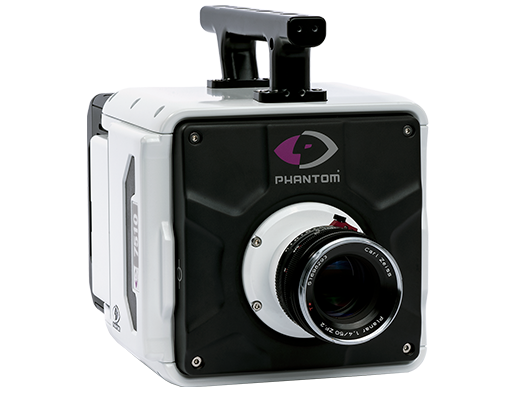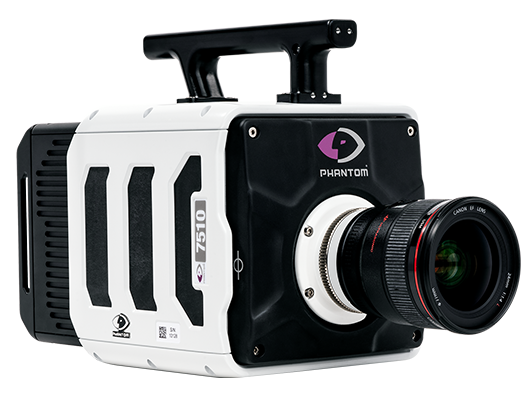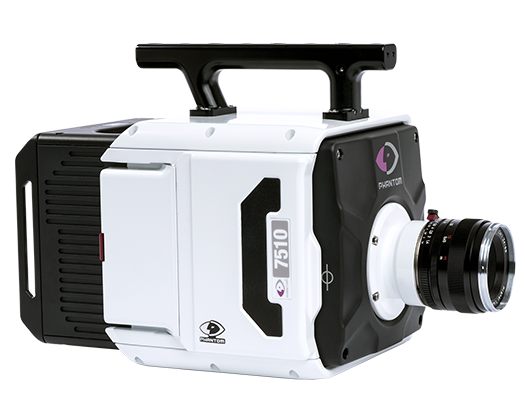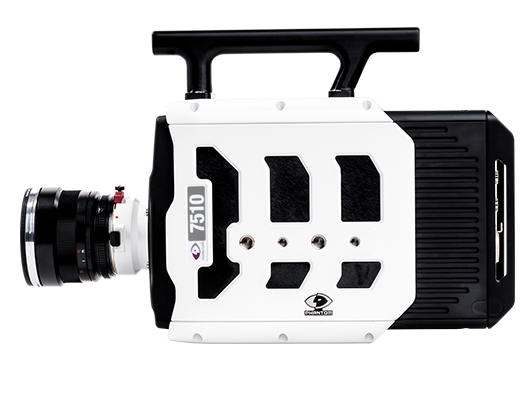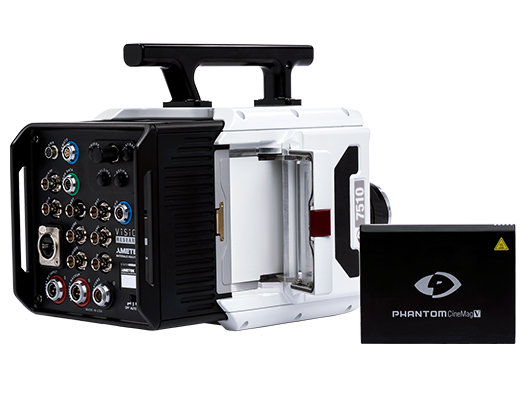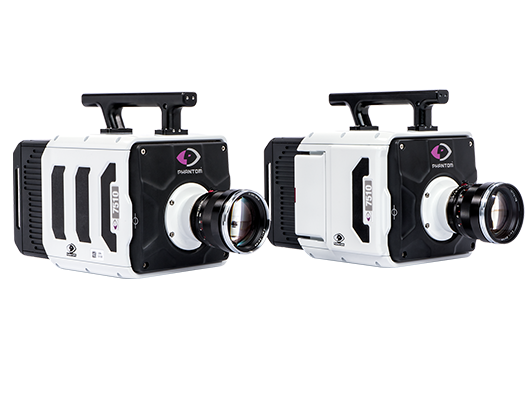TMX 7510
The Phantom TMX 7510 is designed for true high-speed performance. The back side illuminated (BSI) high-speed camera sensor delivers unprecedented resolution and speed combinations. Its focus on data management makes work flow easy.
- 76,000 fps at 1280 x 800
- Sensitivity: Quantum Efficiency*
- Mono: 77.6%; Binned 72.0%
- Color: 64.9%
- Up to 512GB RAM
- Binning Mode for added flexibility
*QExFF at 532nm
The Phantom TMX 7510 is the world's first high-speed camera to utilize back side illumination. Implementing this technology has allowed Vision Research engineers to develop a custom sensor capable of unprecedented speeds without sacrificing the image quality that Phantom cameras are known for.
BSI technology provides increased processing efficiency, allowing TMX cameras to maintain their high throughput levels even as frame rates increase. The TMX 7510 has 75 Gigapixel throughput which can provide over 76,000 fps at a full 1 Mpx resolution of 1280 x 800. At reduced resolutions the camera will record at over 744,000 fps in standard mode and up to 1.75M fps and 95ns in with the FAST mode. For an in-depth look at how this technology has revolutionized high-speed imaging read our whitepaper on BSI Sensor Technology.
One truth of high-speed imaging that never changes is that, 'with increased speeds comes the need for increased light'. The unique back side illuminated sensor found in the Phantom TMX 7510 deals with this issue by locating the metal parts of a traditional sensor that interfere with incident light to the photodiode to the back of the sensor. Moving those key elements to the back of the sensor allows even more light to reach each pixel, improving light sensitivity and QE.
This revolutionary platform is part of a generation of cameras that deliver greater throughput, premium features, and enhanced performance. Flexibility is key to ensuring that the TMX 7510 is capable of producing images that scientific analysts require. The ability to select binning mode allows for a variety of resolutions without sacrificing speed. In standard mode the TMX 7510 can reach over 300,000 fps at 1280 x 192 (long, thin rectangle), but if switched into binning mode the same speeds are possible at 640 x 384 (shorter and wider rectangle). The difference in resolution options means that researchers are better able to fit the camera sensor output to the size and shape of their high-speed event. These incredible speeds mean that data management is vital to ensuring as little downtime as possible. The Phantom TMX 7510 has up to 512GB of onboard RAM, can be fitted to use our custom non-volatile data storage, the Phantom CineMag, and comes equipped with 10Gb Ethernet download as a standard. All of these workflow tools are available on every TMX.
Like most Phantom cameras the TMX 7510 has interchangeable lens mounts (PL, C, M42 and Canon EOS) which enables the use of high quality and specialized optics without limitation. The camera mount can be customized for each particular test as needed.
Key Features
- 18.5 micron pixel
- 12-bit depth
- Side mounting
- Full Phantom Features and connectivity
- Programmable I/O - Assign and define camera signals
What's in the box?
- 400 W Power supply with XLR extender
- Ruggedized ethernet cable
- BNC cable
- Sturdy Pelican case and customized foam
| Resolution | FPS |
|---|---|
| 1280 x 800 | 76,000 |
| 1280 x 192 | 308,820 |
| 1280 x 128 | 456,520 |
| 1280 x 64 | 744,670 |
| 1280 x 64* | 875,000 |
| 1280 x 32* | 1,750,000 |
Binned Mode
| Resolution | FPS |
|---|---|
| 640 x 384 | 308,820 |
| 640 x 320 | 375,000 |
| 640 x 256 | 456,520 |
| 640 x 192 | 617,640 |
| 640 x 128 | 744,670 |
| 640 x 128* | 875,000 |
| 640 x 64* | 1,750,000 |
*FAST Option, export controlled
- The Phantom TMX 7510 1-Mpx camera has the industry's first high-speed back side illuminated (BSI) sensor,
- Designed for true high-speed performance.
- 76,000 fps at full 1280 x 800 resolution
- 1.75M fps with FAST option at reduced resolutions.
- 75 Gpx/second
- Minimum frame rate is 100 fps
- Standard Mode Max Speeds:
- 1280 x 800 is 76,000 fps. (full resolution)
- 1280 x 64 is 744,670 fps
- 1280 x 32 - 1.75M fps (FAST option only)
- Binned Mode Max Speeds:
- 640 x 384 in the Binned mode is 308,820 fps (full resolution)
- 640 x 128 is 744,670 fps
- 640 x 64 - 1.75M fps (FAST option only)
- CMOS Back Side Illuminated (BSI) Sensor
- 1280 x 800 pixels
- 18.5 µm pixel size, 37 µm with binning enabled
- 23.7 mm x 14.8 mm; 27.94mm diagonal
- 12-bit depth
- CAR in 256 x 32 increments, 128 x 64 in Binned modes
- Standard Mode:
- Quantum Efficiency: 77.6% mono; 64.9% color
- Max. SNR: 39.4 dB
- AST (p) 31.8 mono; 44.4 color
- Saturation Capacity (e-): 8736 mono; 9720 color
- Temporal Dark Noise: 24.18 e-
- Dynamic Range: 51.0 dB
- Binned Mode:
- Quantum Efficiency: 72.0%
- Max. SNR: 45.2 dB
- AST (p) 98.9
- Saturation Capacity (e-): 33,184
- Temporal Dark Noise: 70.69 e-
- Dynamic Range: 53.4 dB
- Binned Mode is Mono Output Only
- 1.04 µs minimum exposure standard, 95 ns minimum exposure with 95ns FAST option, or 38 ns minimum exposure with 38ns FAST option (both options are export controlled)
- Exposure Index (E.I.) for controlling apparent ISO
- Shutter Off mode for PIV
- 128GB, 256GB, 512GB high-speed internal RAM.
- Up to 511 memory partitions.
- CineMag V for non-volatile storage (2TB, 8TB)
- 4.4 seconds at maximum frame rate,12 bits, 1280 x 800 resolution and into maximum internal memory
- Longer record times are possible at reduced resolutions and when recording directly to a CineMag at lower frame rates
- 10Gb Ethernet standard
- Binned mode for double the vertical resolution at high frame rates (Monochrome Output Only)
- Multi-cine mode and up to 511 memory segments
- Continuous recording
- Event marking
- Frame timestamp
- IRIG In (modulated and unmodulated)
- IRIG Out (unmodulated)
- Sync-to-Trigger
- Shutter off mode for PIV exposure
- 229 ns straddle time
- Burst mode
- Internal mechanical shutter for automatic/remote Current Session Reference (CSR)
- DHCP or Secondary IP address
- Field-based firmware upgrade capable
- Programmable trigger location (pre/post trigger recording)
- Image-Based Auto-Trigger standard
- Trigger from software
- Hardware trigger BNC
- Frame synchronization to internal or external clock (FSYNC)
- IRIG in/out
- Ready output (high when camera is armed and ready to record)
- Strobe output (low during frame exposure time)
- Dedicated Trigger, Timecode In ports
- Dedicated Remote port for RS232
- Dedicated Range Data
- 4 Programmable I/O ports includes adjustable (assign and define) signals including:
- F-sync
- strobe
- event
- trigger output
- ready and more
- Gb Ethernet (standard)
- 10Gb Ethernet standard for control and data downloads
- WiFi via USB Dongle for control
- (option to order from factory with disabled WiFi)
- Phantom Camera Control Software (PCC)
- On-Camera Controls (OCC)
- SDK available
- 2X 3G HD-SDI ports
- Supports up to 1080p60.
- Nikon F-mount standard, supports F & G style lenses
- Canon EOS mount optional
- PL-mount optional
- C-mount optional
- M42-mount optional
- (lens not included)
- Brightness
- Gain
- Gamma
- Saturation
- White Balance
- Pedestal
- Tone curve
- Filters
- Color matrix
- Image flip and rotate
- Crop
- Scale
- National Instruments M- and X-Series DAQ modules with integrated support in PCC
- Basic measurements via Phantom Application:
- Distance
- Speed
- Acceleration
- Angles and Angular Speed
- Manual and Automatic point collection for target tracking
- Compatible with 3rd party solutions
- Cine RAW & Cine Compressed
- AVI, h.264 mp4
- Apple ProRes .mov
- Multipage TIFF
- MXF PAL & MXF NTSC
- Uncompressed QuickTime
- Windows BMP
- OS/2 BMP, PCX, TGA
- TIFF, LEAD, JPEG
- JTIF, RAW, DNG, DPX
- 100 - 240 VAC, 400 Watt power supply included
- 20 - 28 VDC secondary power input on camera back panel
- CineMag
- 7 x 7.4 x 11.7 inches, 17.8 x 18.6 x 29.7 cm (H, W, L)*
- weight: 20 lbs, 9.1 kg
- Non-CineMag
- 7 x 7 x 11.7” (17.8 x 17.8 x 29.7 cm)*
- Weight: 20 lbs, 9.1 kg
- *Handle adds 2 inches (5.2 cm) to height.
- Operating Temperature: -10 to +50 C
- Storage Temperature: -20 to + 70 C
- Regulatory(EMI/EMC/ESD):
- Emissions: EN 61326-1, FCC part 15
- Immunity: EN 61326-1
- Shock:
- Operational: MIL-STD-202H Method 213-B. Rated 30G, sawtooth wave, 11 ms, +/- 10 pulses all axes.
- Vibration:
- MIL-STD-202H Method 214-i; Test Condition A.
- Rated 5.3 Grms; 15 min/axis
- Safety: IEC 60950-1
- Phantom SDK
- LabView
- MatLab
- Power supply 400W w/ XLR cable
- Ruggedized Ethernet cable
- BNC cable
- Phantom PCC software
- Getting Started Guide
- Rugged case with custom foam for protection
- FAST Option
- Canon EOS mount
- C Mount
- PL Mount
- M42 mount
- LED lights
- CineMag V
- CineStation IV
- Video monitor for use with on-camera controls

TMX Power Supply
400W Power Supply with 3-pin XLR to 3-pin Fischer Power cable for TMX Cameras

TMX Ruggedized Cable

Monitor

Phantom CineMag 5

Phantom CineStation IV

Pickle Switch, 6' (2m) Cable
The Phantom TMX Series are the first high-speed cameras to use back side illuminated (BSI) sensor technology. Other high-speed cameras use Front Side Illuminated (FSI) sensor technology. In BSI sensors, the photodiode is closer in the sensor architecture to the light source, while the metal circuitry of the sensor is behind the photodiode.
This architecture provides two main benefits. The first is improved light sensitivity and Quantum Efficiency because the photodiode is closer to light source and not impeded by metal circuitry. The second is maintained throughput as frame rates increase, because the metal behind the photodiode can be redesigned for higher efficiency. Simply said, as frame rates increase, the BSI technology in TMX can offer much larger resolutions than available in cameras with FSI technology.
The TMX Series have a single RJ45 Ethernet port that is auto-negotiating to either a Gb Ethernet or a 10Gb Ethernet interface. This capability is a standard feature. When optimized, the 10GB Ethernet interface allows for cine downloads at speeds more than 5X faster than the standard Gb Ethernet interface.
While any compatible 10GBASE-T interface card installed in a PC should work, we have been using and recommending the Intel X540-T1 and X540-T2 cards. Be sure the latest Intel drivers are installed, and the appropriate network address is assigned to it (For example, IP 172.16.0.1 and Subnet 255.255.0.0) Also, ensure either the Phantom 10G Network driver is installed.
The RJ45 port on TMX has a locking mechanism. It works with standard Ethernet cables, or, for a more secure connection, Vision Research provides a ruggedized CAT 6A Ethernet cable with the mating locking component on one end.
A CAT6 or CAT7 cable is recommended and gives you a maximum 100m distance between the camera and the interface card. (A CAT6 cable is limited to 50m.)
Yes. In fact, there is a viewfinder port (VF) on the camera that will supply video and power to a viewfinder or monitor. Many standard monitors may be used. The TMX cameras have 2 BNC ports that provide HD-SDI.
All TMX digital cameras come with a 400W power supply, providing ample power for a camera with maximum 512GB memory, a CineMag, and the viewfinder.
Yes. You need to order the optional Canon EOS lens mount and use it with one of the tested and supported lenses (see FAQ). The part number is: VRI-MNT-TMX-EOS.
What you end up actually saving in memory is a function of how you've set up your trigger. It can be set so that only frames that occur after the trigger are saved (100% post trigger). In this mode, once the trigger is pressed any images already in memory are overwritten and you record until memory is full, then it stops. If you set the trigger to stop the recording (0% post trigger) and save all frames up to the time of the trigger, the camera will simply stop recording upon the trigger and all the frames in memory before the trigger will be saved. Finally, you can set the trigger anywhere in the middle, for example having 90% of the recorded movie be what happens prior to the trigger and 10% after the trigger.
On-site training is available.
For customers outside of North America, who prefer local training, most of our International Sales Partners offer training courses tailored to your needs.
If your application is TV or Motion Picture production, consider training courses targeted at those applications from AbelCine, or other Phantom resellers around the world who focus on the "entertainment" market.
BSI Video
Revolutionary back side illuminated high-speed sensor technology from Vision Research that has set new standards in resolution, speed, and sensitivity capabilities.





Downloads
-
GET MORE INFORMATION ABOUT PHANTOM PRODUCTS
- Contact us












